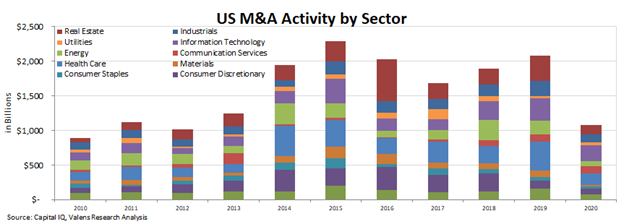The M&A market is making a strong comeback… just not everywhere

There are two main ways companies can grow – organically and through mergers and acquisitions (M&A).
M&A activity came to a virtual standstill at the beginning of the pandemic when companies were uncertain about their cash flows. Now, we’re seeing M&A activity surge in certain industries while remaining muted in others.
Today, we will look at the M&A market and see what it means for different sectors and companies.
Investor Essentials Daily:
The Monday Macro Report
Powered by Valens Research
A major part of the “Survive and Thrive” theme is M&A.
The larger and more successful firms, the likely winners of Survive and Thrive, have healthy balance sheets and are looking to put their capital to work.
After a major market selloff, M&A is a great way to deploy capital efficiently as many companies have lost value. Although M&A activity slowed down initially during the pandemic, it looks like activity may be picking up.
As this Economist article highlights, there may be a few reasons why this is occurring. The first could be around the pressure of the pandemic easing off, without the return to normalcy. CEOs and other C-suite executives were constantly putting out fires when the pandemic began.
Now, there is more certainty in the economy and many of these executives are working at home and going stir-crazy. Because of this, they are looking at long-term ways to improve their companies. M&A activity is one way to accomplish this.
Additionally, many companies have seen stock prices soar since the market trough in March. Specifically, companies in the Technology sector have stock prices well above pre-pandemic levels. These lofty valuations make for valuable currency in an acquisition.
Salesforce (CRM) took advantage of its high stock price when it announced its acquisition of Slack (WORK) two weeks ago. In addition to paying Slack shareholders in cash, they are also receiving Salesforce shares. Those shares are worth roughly double what they were earlier in the year.
The last reason why acquisitions are becoming more popular is because interest rates are so low. This makes borrowing money to pursue acquisitions cheaper, and therefore more attractive.
All these factors set up an environment that is positive for serial acquirers and the winners in the Survive and Thrive market.
Yet, even with the surging fundamentals for acquisitions, M&A activity is still down this year.
This is in large part due to a cancellation and postponement of transactions when the pandemic first hit. It was nearly impossible for companies to predict performance–executives had to call off mergers and acquisitions.
Additionally, firms were worried about their own ability to continue paying off obligations. They could not afford to spend capital on acquisitions, even if the opportunities looked attractive.
Both global and US transactions are near levels not seen since 2008 and 2009. The M&A market took off in 1998 and has been relatively hot since then. Specifically, between 2014 and 2019, both global and US levels were robust and were at or near all-time highs. It now looks like this elevated stretch of activity is coming to an end.
However, the decline has not been similar. Certain sectors have seen activity crumble, while others are near normal levels.
The Technology sector has seen an increase in transaction volume. Many of the companies have benefited from the “At-Home Revolution” and have seen their stocks rise. Some of these firms, like Salesforce, are now looking to strike while the iron is hot.
As such, M&A transactions are returning to normal levels. The Q3 2020 is the third highest quarterly nominal M&A transaction value for the Technology sector in the past decade.
On the other hand, sectors like Healthcare and Real Estate have not seen the same uptick in activity. Year-to-date transaction value for Health Care is roughly one-third of last year’s, and Real Estate is roughly half.
While these sectors are seeing fewer M&A transactions now, this may not continue going forward. As we mentioned earlier, the Survive and Thrive theme has created winners who are looking for opportunities. The pandemic has changed the landscape of these sectors, and there have been both winners and losers. The winners are looking for possible firms to acquire and the losers need help.
For these reasons, industries like Health Care and Real Estate might now be on the catch-up. As executives get more comfortable with their cash flows, they might want to use that and easy debt to engage in M&A activity.
Knowing this, it will be important to watch out for firms which will be acquirers in the coming months. Companies with strong balance sheets and elevated stock prices will be on the lookout for smaller firms.
Understanding which companies are set up to survive and thrive will also mean knowing which companies are going to be the consolidators in these industries.
Best regards,
Joel Litman & Rob Spivey
Chief Investment Strategist &
Director of Research
at Valens Research






